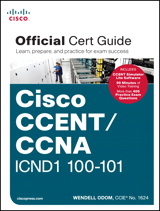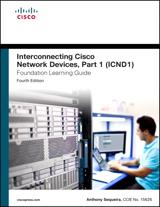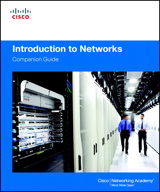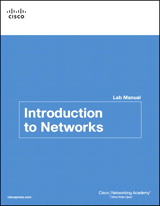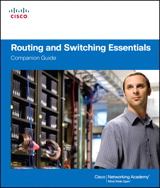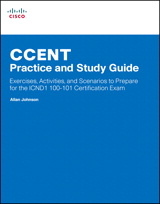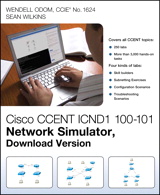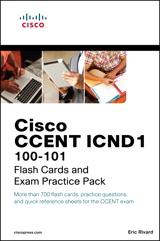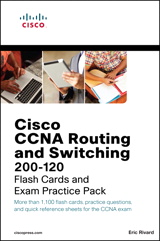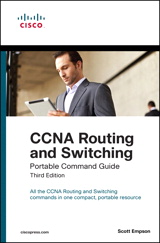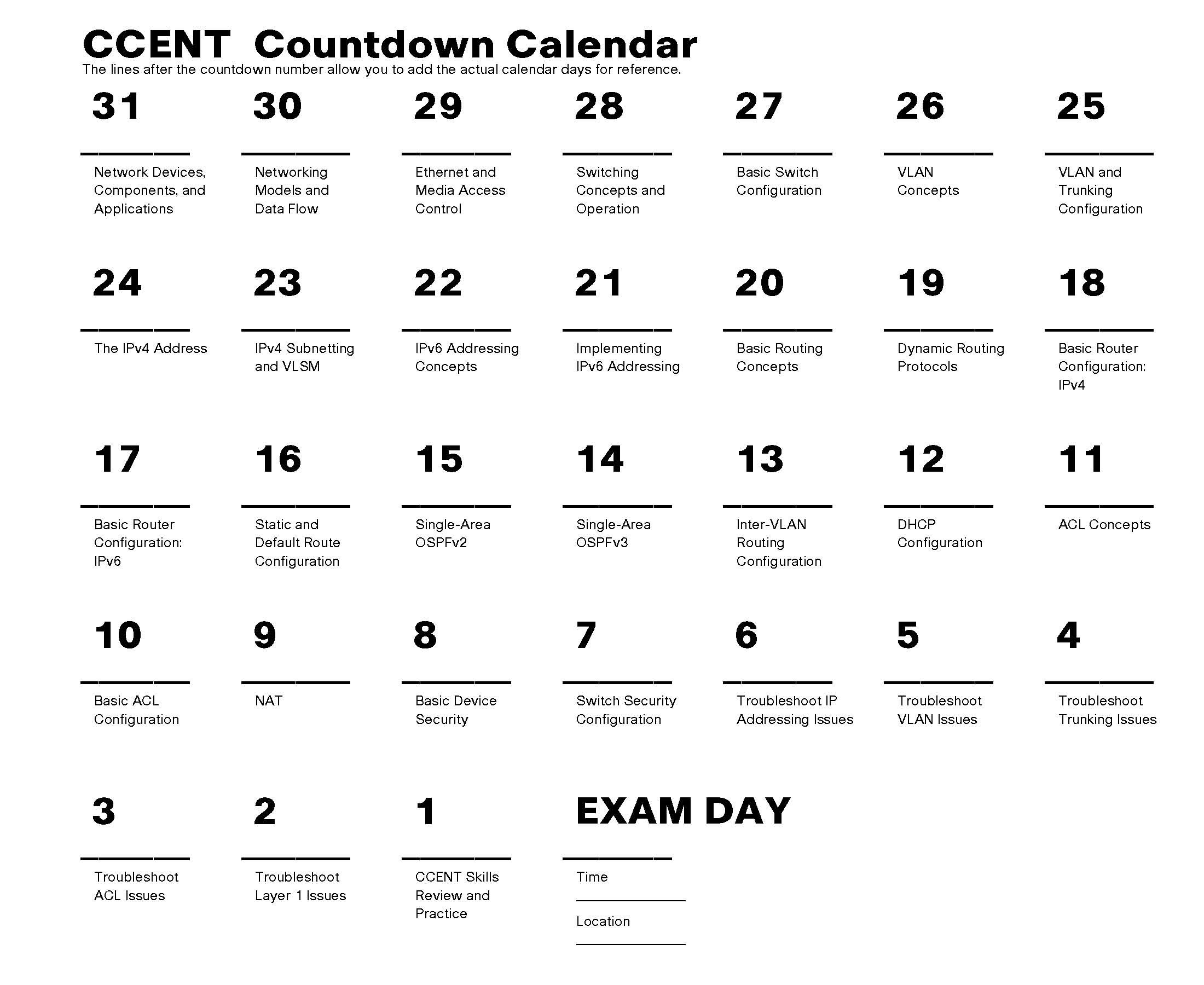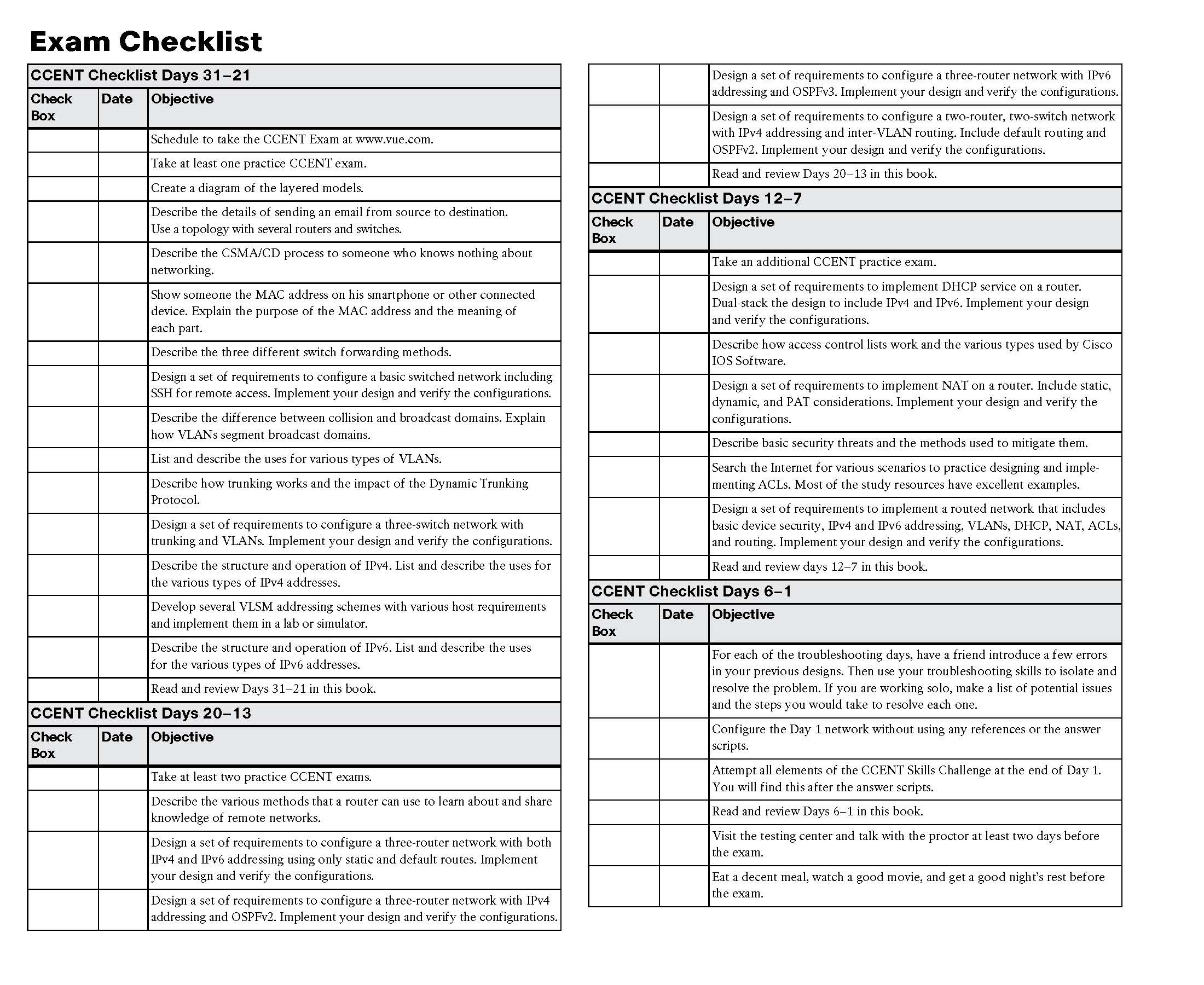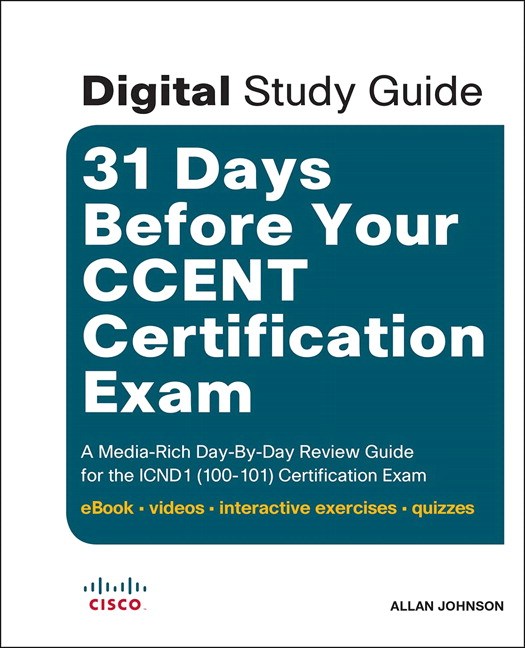
Author: Allan Johnson
Publisher: Cisco Press
ISBN: 978-0-13-421373-6
Copyright © 2015 Cisco Systems, Inc.
Contents at a Glance
Registering for the CCENT 100-101 Exam
Day 31. Network Devices, Components, and Applications
Day 30. Networking Models and Data Flow
Day 29. Ethernet and Media Access Control
Day 28. Switching Concepts and Operation
Day 27. Basic Switch Configuration
Day 26. VLAN Concepts
Day 25. VLAN and Trunking Configuration
Day 24. The IPv4 Address
Day 23. IPv4 Subnetting and VLSM
Day 22. IPv6 Addressing Concepts
Day 21. Implementing IPv6 Addressing
Day 20. Basic Routing Concepts
Day 19. Dynamic Routing Protocols
Day 18. Basic Router Configuration: IPv4
Day 17. Basic Router Configuration: IPv6
Day 16. Static and Default Route Configuration
Day 15. Single-Area OSPFv2
Day 14. Single-Area OSPFv3
Day 13. Inter-VLAN Routing Configuration
Day 12. DHCP Configuration
Day 11. ACL Concepts
Day 10. Basic ACL Configuration
Day 9. NAT
Day 8. Basic Device Security
Day 7. Switch Security Configuration
Day 6. Troubleshoot IP Addressing Issues
Day 5. Troubleshoot VLAN Issues
Day 4. Troubleshoot Trunking Issues
Day 3. Troubleshoot ACL Issues
Day 2. Troubleshoot Layer 1 Issues
Day 1. CCENT Skills Review and Practice
Exam Day
Post-Exam Information
Introduction
You are almost there! If you’re reading this Introduction, you’ve probably already spent a considerable amount of time and energy pursuing your CCENT certification. Regardless of how you got to this point in your travels through your CCENT studies, 31 Days Before Your CCENT Certification Exam most likely represents the last leg of your journey on your way to the destination: to become a Cisco Certified Entry Networking Technician. However, If you are like me, you might be reading this Digital Study Guide at the beginning of your studies. If this is the case, this Digital Study Guide provides you with an excellent overview of the material that you must now spend a great deal of time studying and practicing. However, I must warn you: Unless you are extremely well-versed in networking technologies and have considerable experience configuring and troubleshooting Cisco routers and switches, this Digital Study Guide will not serve you well as the sole resource for CCENT exam preparation. Therefore, let me spend some time discussing my recommendations for study resources.
Study Resources
Cisco Press offers an abundance of CCNA-related books to serve as your primary source for learning how to install, configure, operate, and troubleshoot small- to medium-size routed and switched networks.
Primary Resources
First on the list must be Wendell Odom’s Cisco CCENT/CCNA ICND1 100-101 Official Cert Guide (ISBN: 9781587143854). If you do not buy any other books, buy this one. Wendell’s method of teaching, combined with his technical expertise and down-to-earth style, is unsurpassed in our industry. As you read through his books, you sense that he is sitting right there next to you walking you through the material. The practice exams and study materials on the DVD in the back of the book are worth the price of the book. There is no better resource on the market for a CCNA candidate.
Next on the list must be Anthony Sequeira’s Interconnecting Cisco Network Devices, Part 1 (ICND1) Foundation Learning Guide (ISBN: 9781587143762). This book is indispensable to those students who take the first of two Cisco-recommended training classes for CCNA preparation: Interconnecting Cisco Network Devices 1 (ICND1). These courses, available through Cisco Training Partners in a variety of formats, are usually of a very short duration (one to six weeks) and are geared toward the industry professional already working in the field of networking. Anthony’s book serves the reader well as a concise, but thorough, treatment of the CCENT exam topics. His method and approach often differ and complement Wendell’s approach. I recommend that you also refer to this book.
If you are a Cisco Networking Academy student, you are blessed with access to the online version of the CCNA Routing and Switching curriculum and the wildly popular Packet Tracer network simulator. I used the Introduction to Networking (ITN) and Routing and Switching Essential (RSE) courses in my daily review of the exam topics. ITN introduces basic concepts of computer networks, including deep dives into the seven layers of the OSI model, IP addressing, and the fundamentals of Ethernet. Successfully completing the course means that you should be able to build small LANs and implement basic addressing and configurations on routers and switches. RSE expands on ITN, taking the student further into basic router and switch configuration. Successfully completing the course means that you should be able to configure and troubleshoot routers and switches using a variety of technologies including RIPv2, single-area OSPF, VLANs, and inter-VLAN routing for both IPv4 and IPv6 networks. To learn more about CCNA Routing and Switching courses and to find an Academy near you, visit www.netacad.com.
However, if you are not an Academy student but would like to benefit from the extensive authoring done for these courses, you can buy any or all the CCNA Routing and Switching Companion Guides (CG) and Lab Manuals (LM) of the Academy’s popular online curriculum. Although you will not have access to the Packet Tracer network simulator software, you will have access to the tireless work of an outstanding team of Cisco Academy Instructors dedicated to providing students with comprehensive and engaging CCNA preparation course material. The titles and ISBNs for the CCNA Routing and Switching CGs and LMs are as follows:
- Introduction to Networks Companion Guide (ISBN: 9781587133169)
- Introduction to Networks Lab Manual (ISBN: 9781587133121)
- Routing and Switching Essentials Companion Guide (ISBN: 9781587133183)
- Routing and Switching Essentials Lab Manual (ISBN: 9781587133206)
Supplemental Resources
There are four more supplemental resources I recommend to augment your final 31 days of review and preparation.
First, a plug for my own book, the CCENT Practice and Study Guide, Exercises, Activities and Scenarios to Prepare for the ICND1/CCENT (100-101) Certification Exam (ISBN: 9781587133459). The subtitle is a concise summary of what you will get. Although an appropriate resource for anyone, this book is specifically geared toward the Cisco Networking Academy instructors and students who want a resource to supplement the online curriculum. Mirroring the chapter layout of the first two online courses, the CCENT PSG offers exercises that help you learn the concepts and configurations that are crucial to your success as a CCENT candidate.
Second, Wendell Odom and Sean Wilkins have created over 250 structured labs that are available in the Cisco CCENT ICND1 100-101 Network Simulator (ISBN: 9780133432770). (This link and ISBN are for the downloadable version but a disc-based product of the same simulator is also available.) These simulations map precisely to chapters in his book, but are also a great practice resource for anyone. The four types of labs in this product present you with progressively more difficult real-world challenges. Skill builder labs help you practice short, focused configuration tasks. Subnetting exercises help you improve the speed and accuracy of your subnetting calculations. Complex Configuration Scenario labs present realistic multilayered, multitechnology configuration tasks. Finally, challenging Troubleshooting Scenario labs provide you with an opportunity to test your problem identification and resolution skills. If you need that extra edge or are struggling with a particular configuration or troubleshooting concept, you’ll find these simulations very helpful. You can learn more about the network simulators at: http://www.pearsonitcertification.com/imprint/series_detail.aspx?ser=2538752.
Third, Eric Rivard is the author of Cisco CCENT ICND1 100-101 Flash Cards and Exam Practice Pack (ISBN: 9781587203992). The text portion of the book includes over 450 flash cards that quickly review exam topics in bite-sized pieces. Also included is over 100 pages in the Quick Reference Guide, which is designed for late-stage exam preparation. And on the included CD, you will find a test engine with over 150 CCENT practice exam questions.
NOTE: If you are certain that you will be also pursuing your CCNA certification, the more economical purchase might be to buy the Cisco CCNA Routing and Switching 200-120 Flash Cards and Exam Practice Pack (ISBN: 9781587204005). The first half of this book is a repeat of the CCENT version.
Fourth, there is Scott Empson’s very popular CCNA Routing and Switching Portable Command Guide, Third Edition (ISBN: 9781587204302). This guide is way more than just a listing of commands and what they do. Yes, it summarizes all the CCNA certification-level IOS commands, keywords, command arguments, and associated prompts. But it also provides you with tips and examples of how to apply the commands to real-world scenarios. Configuration examples throughout the book provide you with a better understanding of how these commands are used in simple network designs.
Additional Resource
An additional resource you may have used during your studies is the CCENT ICND1 100-101 Complete Video Course. Kevin Wallace leads you through all the objectives of the ICND1 exam in over 17 hours of video instruction. In addition to expert video course instruction and examples the CCENT ICND1 100-101 Complete Video Course also includes review quizzes, glossary quizzes, and interactive exercises.
The Cisco Learning Network
Finally, if you have not done so already, you should now register with The Cisco Learning Network at https://learningnetwork.cisco.com. Sponsored by Cisco, The Cisco Learning Network is a free social learning network where IT professionals can engage in the common pursuit of enhancing and advancing their IT careers. Here you will find many resources to help you prepare for your CCNA exam as well as a community of like-minded people ready to answer your questions, help you with your struggles, and share in your triumphs.
So which resources should you buy? That question is largely up to how deep your pockets are or how much you like books. If you’re like I am, you must have it all! I admit it. My bookcase is a testament to my Cisco “geekness.” But if you are on a budget, choose one of the primary study resources and one of the supplemental resources, such as Wendell Odom’s certification book and my practice study guide. Whatever you choose, you will be in good hands. Any or all of these authors will serve you well.
Components of this Digital Study Guide
The main goal of this Digital Study Guide is to provide you with a clear and succinct review of the CCENT objectives. Each day’s exam topics are grouped into a common conceptual framework and use the following format:
- A title for the day that concisely states the overall topic
- A list of one or more CCENT 100-101 ICND1 Exam Topics to be reviewed
- A Key Topics section to introduce the review material and quickly orient you to the day’s focus
- An extensive review section consisting of short paragraphs, lists, tables, examples, and graphics
- A Study Resources section to provide you with a quick reference for locating more in-depth treatment of the day’s topics
The Digital Study Guide counts down starting with Day 31 and continues through exam day to provide post-test information.
Here are a calendar and checklist in PDF format that you can download and fill out to use during your exam preparation.
Use the calendar to enter each actual date beside the countdown day and the exact day, time, and location of your CCENT exam. The calendar provides a visual for the time that you can dedicate to each CCENT exam topic.
The checklist highlights important tasks and deadlines leading up to your exam. Use it to help you map out your studies.
With the Digital Study Guide edition you can also
- Watch an expert instructor demonstrate configurations, explain important topics, and visually describe some key ICND1 exam objectives in 3 hours of unique embedded video created to support specific topics in the text.
- Reinforce key network concepts with dynamic and interactive hands-on exercises and see the results with the click of a button.
- Test your understanding of the material at the end of each Day with a fully interactive online quiz.
Who Should Use This Digital Study Guide
The audience for this Digital Study Guide is anyone finishing his or her preparation for taking the CCENT 100-101 ICND1 exam. A secondary audience is anyone needing a refresher review of CCENT exam topics—possibly before attempting to recertify or sit for another certification to which the CCNA is a prerequisite.
Getting to Know the CCENT 100-101 ICND1 Exam
For the current certifications, announced in spring 2013, Cisco created the ICND1 (100-101) and ICND2 (200-101) exams, along with the CCNA (200-120) exam. To become CCENT certified, you only need to pass the ICND1 exam. To become CCNA Routing and Switching certified, you must pass both the ICND1 and ICND2 exams, or just the CCNA exam. The CCNA exam simply covers all the topics of the ICND1 and ICND2 exams, giving you two options for gaining your CCNA Routing and Switching certification. The two-exam path gives people with less experience a chance to study for a smaller set of topics at one time. The one-exam option provides a more cost-effective certification path for those who want to prepare for all the topics at once. This Digital Study Guide focuses exclusively on the CCENT path, using the entire list of topics published for the CCENT 100-101 ICND1 exam.
Currently for the CCENT exam, you are allowed 90 minutes to answer 50-60 questions. Use the following steps to access a tutorial at home that demonstrates the exam environment before you go to take the exam:
Step 1. Visit www.vue.com/cisco.
Step 2. Look for a link to the certification tutorial. Currently, it can be found on the right side of the web page under the heading “Related Links.”
Step 3. Click the certification tutorial link.
When you get to the testing center and check in, the proctor verifies your identity, gives you some general instructions and then takes you into a quiet room containing a PC. When you’re at the PC, you have a few things to do before the timer starts on your exam. For instance, you can take the tutorial to get accustomed to the PC and the testing engine. Every time I sit for an exam, I go through the tutorial even though I know how the test engine works. It helps me settle my nerves and get focused. Anyone who has user-level skills in getting around a PC should have no problems with the testing environment.
When you start the exam, you are asked a series of questions. Each question is presented one at a time and must be answered before moving on to the next question. The exam engine does not let you go back and change your answer. The exam questions can be in one of the following formats:
- Multiple choice
- Fill-in-the-blank
- Drag-and-drop
- Testlet
- Simlet
- Simulation
The multiple-choice format simply requires that you point and click a circle or check box next to the correct answer or answers. Cisco traditionally tells you how many answers you need to choose, and the testing software prevents you from choosing too many or too few.
Fill-in-the-blank questions typically only require you to type numbers. However, if words are requested, the case does not matter unless the answer is a command that is case sensitive (such as passwords and device names when configuring authentication).
Drag-and-drop questions require you to click and hold, move a button or icon to another area, and release the mouse button to place the object somewhere else--typically in a list. For some questions, to get the question correct, you might need to put a list of five things in the proper order.
Testlets contain one general scenario and several multiple-choice questions about the scenario. These are ideal if you are confident in your knowledge of the scenario’s content because you can leverage your strength over multiple questions.
A simlet is similar to a testlet in that you are given a scenario with several multiple-choice questions. However, a simlet uses a network simulator to allow you access to a simulation of the command line of Cisco IOS Software. You can then use show commands to examine a network’s current behavior and answer the question.
A simulation also uses a network simulator, but you are given a task to accomplish such as implementing a network solution or troubleshooting an existing network implementation. You do this by configuring one or more routers and switches. The exam then grades the question based on the configuration you changed or added. A newer form of the simulation question is the GUI-based simulation, where a graphical interface like that found on a Linksys router or the Cisco Security Device Manager are simulated.
What Topics Are Covered on the CCENT Exam?
The topics of the CCENT 100-101 ICND1 exam focus on the following seven key categories:
- Operation of IP Data Networks
- LAN Switching Technologies
- IP Addressing for IPv4 and IPv6
- IP Routing Technologies
- IP Services
- Network Device Security
- Troubleshooting
Although Cisco outlines general exam topics, it is possible that not all topics will appear on the CCENT exam and that topics that are not specifically listed might appear on the exam. The exam topics provided by Cisco and included in this Digital Study Guide are a general framework for exam preparation. Be sure to check the Cisco website for the latest exam topics.
Registering for the CCENT 100-101 Exam
If you are starting your 31 Days Before Your CCENT Certification Exam today, register for the exam right now. In my testing experience, there is no better motivator than a scheduled test date staring me in the face. I’m willing to bet that it’s the same for you. Don’t worry about unforeseen circumstances. You can cancel your exam registration for a full refund up to 24 hours before taking the exam. So if you’re ready, you should gather the following information and register right now!
- Legal Name
- Social Security or Passport Number
- Company Name
- Valid Email Address
- Method of Payment
- Cisco Certification ID or Test ID (Applies to exam candidates who have previously taken a Cisco certification exam)
- Cisco Academy Username (Applies to Cisco Networking Academy students only)
- Cisco Academy ID Number (Applies to Cisco Networking Academy students only)
- Voucher Number (Applies to Cisco Networking Academy students only)
To register for an exam, visit Pearson VUE online at www.vue.com/cisco. The process and available test times will vary based on the local testing center you choose.
Remember, there is no better motivation for study than an actual test date. Sign up today.
About the Author
Allan Johnson entered the academic world in 1999 after ten years as a business owner/operator to dedicate his efforts to his passion for teaching. He holds both an MBA and an M.Ed. in occupational training and development. He taught CCNA courses at the high school level for seven years and has taught both CCNA and CCNP courses at Del Mar College in Corpus Christi, Texas. In 2003, Allan began to commit much of his time and energy to the CCNA Instructional Support Team, providing services to Networking Academy instructors worldwide and creating training materials. He now works full time for Cisco Networking Academy as a learning systems developer.
Feedback Information
At Cisco Press, our goal is to create in-depth technical books of the highest quality and value. Each book is crafted with care and precision, undergoing rigorous development that involves the unique expertise of members from the professional technical community.
Readers’ feedback is a natural continuation of this process. If you have any comments regarding how we could improve the quality of this Digital Study Guide, or otherwise alter it to better suit your needs, you can contact us through email at feedback@ciscopress.com. Please make sure to include the title and ISBN in your message.
We greatly appreciate your assistance.
Icons And Conventions
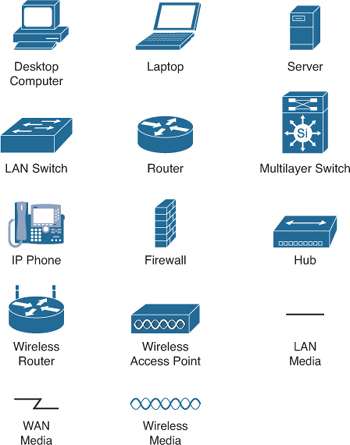
Command Syntax Conventions
The conventions used to present command syntax in this Digital Study Guide are the same conventions used in the IOS Command Reference. The Command Reference describes these conventions as follows:
- Boldface indicates commands and keywords that are entered literally as shown. In actual configuration examples and output (not general command syntax), boldface indicates commands that are manually input by the user (such as a show command).
- Italic indicates arguments for which you supply actual values.
- Vertical bars (|) separate alternative, mutually exclusive elements.
- Square brackets ([ ]) indicate an optional element.
- Braces ({ }) indicate a required choice.
- Braces within brackets ([{ }]) indicate a required choice within an optional element.
